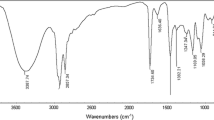Abstract
Surface analysis by X-ray photoelectron spectroscopy (XPS) has shown specific 1∶1 (ionic) interaction between cationic alkyl quaternary surfactant molecules and the anionic sulfonate groups present on the hair surface. The primary driving force for the adsorption of alkyl quaternary amine molecules to the surface of the hair from aqueous solution is the ionic interaction between quaternary groups and the surface SO3 − on the hair. Cationic quaternary molecules incorporating ester and alcohol functionalities (ester quats) demonstrate a lower number of surface quaternary nitrogens per sulfonate group, indicating an altered surface interaction mechanism. For the ester quats, a combination of electrostatic interaction modes exists in addition to the ionic N+/SO3 − interaction, specifically, H-bonding interactions of the −C−O, −C−OH, and −C(O)O− polar groups with SO3 − and other polar groups on the hair. Surface coverage of the ester quat is not reduced despite the decrease in ionic interaction at the surface. Both types of molecules orient their alkyl tails toward the surface. Molecular dynamics modeling of the surfactant/hair surface interaction indicates higher adsorption energies due to increased dipolar interactions for ester quat molecules.
Similar content being viewed by others
References
Swift, J.A., Fundamentals of Human Hair Science, Micelle Press, Dorset, England, 1997, 96 pp.
Robbins, C.R., Chemical and Physical Behavior of Human Hair, Springer-Verlag, New York, 1988.
Millard, M.M., Analysis of Surface Oxidized Wool Fiber by X-Ray Electron Spectrometry, Anal. Chem. 44:828 (1972).
Standard Practice for Checking the Operating Characteristics of X-Ray Photoelectron Spectrometers, American Society for Testing and Materials, West Conshohocken, PA).
Stranick, M.A., Determination of Negative Binding Sites on Hair Surface Using XPS and Ba2+ Labeling, Surf. Interface Anal. 24:522 (1996).
Robbins, C.R., and M.K. Bahl, Analysis of Hair by Electron Spectroscopy for Chemical Analysis, J. Soc. Cosmet. Chem. 35:379 (1984).
Dreiling, M.J., Quantitative Surface Measurements of Metal Oxide Powders by X-ray Photoelectron Spectroscopy (XPS), Surf. Sci. 71:231 (1978).
Bain, C.D., E.B. Troughton, Y.-T. Tao, J. Evall, G.M. Whitesides, and R.G. Nuzzo, Formation of Monolayer Films by the Spontaneous Assembly of Organic Thiols from Solution onto Gold, J. Am. Chem. Soc. 111:321 (1989).
Tanuma, S., C.J. Powell, and D.R. Penn, Calculations of Election Inelastic Mean Free Paths. V. Data for 14 Organic Compounds over the 50–2000 eV Range, Surf. Interface Anal. 21:165 (1993).
Robbins, C.R., E. Reich, and A. Patel, Adsorption to Keratin Surfaces: A Continuum Between a Charge-Driven and a Hydrophobically Driven Process, J. Soc. Cosmet. Chem. 45:85 (1994).
Tables of Organic Acid Dissociation Constants, CRC Handbook of Chemistry and Physics, 54 edn. CRC Press, Boca Raton, 1973–1974, Section D129.
Author information
Authors and Affiliations
Corresponding author
About this article
Cite this article
Beard, B.C., Hare, J. Surface interaction of quaternary amines with hair. J Surfact Deterg 5, 145–150 (2002). https://doi.org/10.1007/s11743-002-0214-0
Received:
Accepted:
Issue Date:
DOI: https://doi.org/10.1007/s11743-002-0214-0




